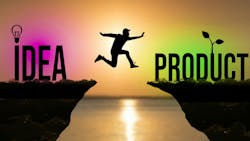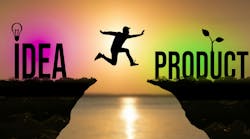From Maker to Market: The Dynamic Journey of Bringing Innovations to Life
What you’ll learn:
- The process of turning a maker project into a product.
- Challenges and recommendations of going from a concept to distributing the product.
In the rapidly evolving world of innovation and entrepreneurship, the journey from a budding idea to a product on the market is both exhilarating and challenging. The "maker to market" process is a complex and multifaceted path that transforms a simple concept into a tangible product for customers.
The success of this journey relies on carefully navigating several critical stages, each playing a vital role in shaping the outcome. These stages—conceptualization, research, evaluation, design, prototyping, funding, marketing, production, distribution, and support—are vital to ensuring that the product not only meets market needs, but also stands out in today’s competitive landscape. Along the way you may need to take advantage of vendors, distributors, and funding platforms like Kickstarter.
Makers Concept: Where It All Begins
Perhaps the birth of a great idea occurred in a dream, came to you in the shower, or sprung up due to a persistent problem. Either way, you’ve got a concept worth exploring. So, begin your process by defining your problem, brainstorming, researching, and even block diagramming. A concept is creating an idea or design to solve a problem. However, before a problem can be solved, you must thoroughly understand it. Only after a problem is understood can it be effectively addressed and solved.
One practical method for solving problems is brainstorming, a group problem-solving technique that involves the spontaneous contribution of all ideas from all group members. Note the phrase “all ideas.” For brainstorming to be effective, the most important rule is that there are no bad ideas.
The Power of Research for a Successful Product
Once an idea is conceived, the next critical step is research. While you’ve probably done a bit of Googling, now is the time to get serious about researching your idea. You’ll need to review platforms, evaluate price points, and perform a competitive analysis. It’s also a great time to investigate existing intellectual property.
Consider different technologies that you may incorporate into your idea. What’s available? How accessible is it? Is the technology something you can learn, or will you need help? By understanding the market, innovators can tailor their products to meet the specific needs of their target audience, setting the stage for a product that resonates with consumers.
Evaluating Potential and Risks in Delivering a Product
As the research phase concludes, the focus shifts to evaluation. Before you spend a lot of time designing your project, you must carefully evaluate it. First, weigh the pros and cons of your project. Consider possible team members, test your technology, and establish a realistic timeline. Does everything check out? If so, you’re ready to design!
To make your product succeed, you need to meet the market’s needs. Examine your previous roadmap step. Research results on the state of current solutions and see how your idea compares. Ask around or conduct a survey to find out what might be the most useful to customers and what features they seek.
After thinking through your ideas and how you might implement them, narrow down your list to the more manageable and profitable few. This stage isn’t just about identifying the strengths of an idea, but also about acknowledging its weaknesses and finding ways to address them.
Makers: Designing for Success
Design is where ideas begin to take physical form. The design journey begins with a spark of creativity or a response to a market need. This initial phase involves brainstorming and conceptualizing the product. Designers and engineers collaborate to develop a clear vision, focusing on functionality, aesthetics, and user experience. The design stage is marked by extensive research to understand market trends, consumer preferences, and potential competitors.
Designers sketch out ideas, create detailed plans, and use various tools and techniques to bring their concepts to life. The goal is to create a product that not only meets a specific need, but also stands out in the marketplace. A strong design phase sets the foundation for a successful product by addressing both practical and emotional aspects of the user experience.
Prototyping: Testing the Waters
Prototyping is the stage where designs are put to the test. The prototyping phase can also be fun and exciting because this is where the proverbial “rubber meets the road.”
When prototyping, you truly discover if your idea and design actually work as expected. Using prototyping platforms like Arduino, BeagleBoard, or Raspberry Pi often make the task easier (see figure). During this phase, prepare yourself for heartache, setbacks, and, most importantly, lessons learned. This is when errors and oversights are discovered and rectified.
Prototyping includes the fabrication and assembly of your printed circuit board (PCB). Depending on the complexity of your PCB design, these prototypes can be either handmade by you or produced using one of the many prototype shops available online or possibly locally. Also included in this phase is testing, such as the initial turn-on test (aka the “smoke” test), which involves energizing your PCB for the first time to ensure it either works as desired — or it smokes.
After your design is working as intended, with no required or desired design changes, the following tests—depending on the end-user of your design—should be considered: lifetime testing, failure-analysis (FA) testing, highly accelerated stress test (HAST), compliance certifications, user ability studies, shock and vibration testing, temperature testing, and failure mode and effects analysis (FMEA). Depending on the successes and failures of the design phase, there may or may not be many iterations to your prototype.
Securing Funding: Fueling the Vision
Money may be the root of all evil, but it’s also the most necessary of all evils. Once a product has been designed and prototyped, the next challenge is securing the necessary funding to bring it to market. Whether through venture capital, crowdfunding, or traditional loans, securing the right financing is crucial for scaling production, marketing, and distribution.
If you need to create accounts, round up investors or apply for grants or fellowships. There’s no time like the present. Set up crowdfunding accounts, take a trip to the bank, or start saving.
Once the desired funding source is identified, it’s important to prepare for it properly. Each type requires a specifically formulated plan to achieve success. For example, bootstrapping while already heavily laden with personal debt would make things difficult, if not impossible. Yet, a small company that’s still trying to define itself would not prepare to meet with venture capitalists until further along in their growth.
Marketing: Crafting the Narrative
With funding secured, the focus shifts to marketing. Marketing is a critical stage that determines how the public perceives a product. In today’s global market, where consumers are bombarded with countless choices, effective marketing captures attention and drives sales.
Makers are a passionate group, inspired by their surroundings and buoyed by creativity and creation. That passion can sometimes shield a maker from the reality that their idea isn’t nearly as interesting to others as it is to themselves. It’s time to generate buzz amongst the outside world.
When you’re considering a marketing plan, you’ll need to think about your branding, steps you’ll take to foster public relations, conventions and conferences you might attend, and networking opportunities. It’s also the right place in the process to begin planning packaging and to start a website—go viral!
Production: Bringing Maker Ideas to Life
As marketing efforts ramp up, the next phase is production—the stage where ideas are transformed into tangible products.
Ahhh, production time. The sweet smell of your final bill of materials (BOM) is in the air; you’re ready to start making some serious decisions. First, you need to decide what the demand might be—how much should you order? You also need to think about the manufacturing supply chain, which will involve making decisions about board houses, manufacturers, and assembly houses.
In production, the design you’ve created is built. To build your product effectively, the manufacturing process must be designed to generate your product with the right quality, quantity, and cost to succeed. Expect some design changes to suit production, as well as running design improvements to the product.
Distribution: Navigating the Final Hurdle
Once production is complete, the focus shifts to distribution, the final hurdle in the journey from maker to market. For engineers and makers trying to move into production, distribution can frequently be forgotten, ignored, or underestimated. Distribution, an essential and complicated part of the process, is where your end-customers will have their first physical interaction with your product.
To make certain that this first impression is a good one, besides being a fantastic product, you need to get it to customers promptly and in a professional, protective package. For this, it’s important to consider where and how to keep your product, how it will be packaged to ensure it’s professional yet reasonably inexpensive, who will physically make the shipment when it is ordered, and what method of shipping will be used and how much it will cost.
Support: Sustaining Success
The journey from maker to market doesn’t end with the sale of a product. The final stage—support—is where long-term success is determined. Now that you’ve successfully entered your choice market, it’s time for maintenance.
During this phase of your process, you’ll focus on processing potential returns, troubleshooting early problems, scaling your operation, offering warranties, and gathering positive reviews. Your reputation will be key if you find a way to manage it. Remember that support is ongoing, and you’re not off the hook yet. With your product out on the market, one incredibly important foundation of your business will be supporting current and future customers with their questions and problems.
The Continuous Cycle of Innovation
The journey from maker to market isn’t linear but rather a continuous cycle of innovation. In industries driven by rapid change and technological advances, the need to innovate never ends. Once a product is launched, the focus shifts to the next big idea, and the cycle begins all over again.
Each stage of the journey, from conceptualization to support, builds upon the previous one, creating a dynamic and evolving process that drives progress and shapes the future of industries. Moving from a concept to distribution is a complex and multifaceted process that requires careful planning, strategic thinking, and a deep understanding of the market.
For industries driven by innovation, this journey is both a challenge and an opportunity that brings a chance to bring new ideas to life, solve real-world problems, and make a lasting impact on the world. By navigating each stage of the journey with diligence and creativity, innovators can turn their ideas into successful products that resonate with consumers and withstand the test of time.
About the Author

Kevin Walseth
Manager, Technical Marketing, DigiKey
Kevin Walseth is a manager of technical marketing at DigiKey. DigiKey is the leader and continuous innovator in the high service distribution of electronic components and automation products worldwide, providing more than 15.6 million components from over 3,000 quality name-brand manufacturers. To learn more about the company, click here.


